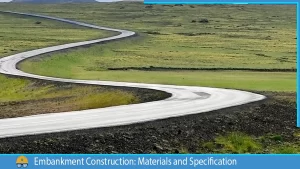There are several layers in the flexible pavement, and it is essential to comprehend their function and contribution to the overall integrity of the road structure. One such critical layer is the Wet Mix Macadam (WMM) layer. In this article, we will explore the significance of the WMM layer in road construction and explore its role in providing a durable and stable road surface.
What is Wet Mix Macadam (WMM)?
Wet Mix Macadam is a pavement layer that involves combining crushed graded aggregates and granular material, such as graded coarse sand, with water in a mixing plant. This mixture is then rolled onto a prepared surface to create a dense mass. Compared to Water Bound Macadam (WBM) construction, It offers numerous advantages, including superior aggregate gradation, faster construction rates, higher densification standards, reduced water consumption, and stricter quality standards.
The specifications for Wet Mix Macadam are suitable for sub-base and base courses and can be executed in multiple layers. The thickness of each individual layer should not be less than 75 mm and can extend up to 200 mm with the use of appropriate compacting equipment.
This, employed in constructing road base and sub-base layers, comprises crushed aggregates like gravel and stone dust. These aggregates are combined with water and a binding agent, such as bitumen emulsion or cement. The resulting mixture is compacted and moulded to create a robust and reliable layer that imparts strength and stability to the road surface.
Also, read: WBM Road: Specifications | Construction | Typical Cross Section
Specification for Wet Mix Macadam
WMM Materials
The materials for WMM are also important to understand in terms of specification.
Aggregate:
The aggregates for WMM typically consist of crushed stone, gravel, or other granular materials. These aggregates are mixed with water and a binder to create a wet mix, which is then compacted and laid as a base layer during road construction.
Generally, the aggregates used in WMM should be hard, durable, and resistant to weathering to provide a stable and long-lasting base for the road.

Physical Requirements:
Grading requirements: The aggregates shall conform to the grading given in Tabic 2.
| SL.NO. | TEST | TEST METHOD | REQUIREMENTS |
|---|---|---|---|
| 1. | Los Angles Abrasion Value Or | IS:2386 (Pan IV) | 40 per cent (Max) |
| Aggregate Impact Value | IS:2386 (Part IV or IS:5640) | 30 per cent (Max) | |
| 2. | Combined Hakiness and Elongation indices (Total) | IS:2386 (Part I) | 30 per cent (Max)*** |
Material finer than 425Micron shall have a Plasticity Index (PI) not exceeding 6.
| IS Sieve Designation | Per cent by Weight Passing Seive | |
|---|---|---|
| Grading 1 | Grading 2 | |
| 53.00 mm | 100 | |
| 45.00 mm | 95-100 | 50-100 |
| 26.50 mm | 100 | |
| 22.40 mm | 60-80 | 50-100 |
| 11.20 mm | 40-60 | |
| 4.75 mm | 25-40 | 35-55 |
| 2.36 mm | 15-30 | |
| 600 Micron | 8-22 | 10-30 |
| 75 Micron | 0-8 | 2-9 |
The choice of the nominal aggregate size in a specific case depends on its availability. Although both gradings can be used for base/sub-base courses, it is crucial to avoid laying the course with Grading No. 1 over the course using Grading No. 2.
Construction Procedure of WMM Road.
The laying of WMM shall not be carried on during rain. The following are the procedures involved in the construction of WMM road:
- Preparation of Base
- Provision of Lateral Confinement of Wet Mix
- Preparation of Mix
- Spreading of Mix
- Compaction
- Setting and Drying
- Opening to Traffic
1. Preparation of Base
Before laying the WMM course, the surface of the sub-grade/sub-base/base must be prepared according to specified lines and cross-fall (camber) and cleared of dust and other debris. Any ruts or soft-yielding areas should be corrected using approved methods and then rolled until a firm surface is achieved, sprinkling of water if needed.
Ideally, it is recommended to avoid laying the WMM course over an existing thick bituminous layer, as this can lead to drainage problems at the interface between the two courses. When WMM is planned to be placed over an existing thin bituminous wearing course, it is preferable to completely excavate the existing layer. However, in areas with low rainfall (less than 1300 mm) and efficient interface drainage, WMM can be laid over the existing thin bituminous surface.
This is achieved by creating 50 mm x 50 mm furrows at a 45-degree angle to the centre line of the pavement at one-meter intervals on the existing road. The furrows ensure sufficient bonding and facilitate water drainage to the granular base course beneath the existing thin bituminous surface.
2. Provision of Lateral Confinement of Wet Mix
During the construction of Wet Mix Macadam (WMM), it is essential to ensure lateral confinement of the wet mix. This is achieved by laying materials adjacent to the shoulders along with the wet mix layer. The construction process should follow a specific sequence, where the shoulder is built in layers, each matching the thickness of the adjoining pavement layer. Only after a layer of pavement and its corresponding layers in the shoulder have been laid and compacted, the construction of the next layer of pavement and shoulder can be undertaken. This sequential approach ensures proper lateral confinement and compaction, leading to a well-structured and durable WMM road.
3. Preparation of Mix
To prepare Wet Mix Macadam (WMM), an approved mixing plant with suitable capacity and controlled water addition, such as a pugmill or pan-type mixer, must be used. For smaller quantities, ordinary concrete mixers may be advisable to use.
The optimum moisture for mixing is determined according to IS:2720 (Part VIII) by replacing the aggregate retained on the 19 mm sieve with material sized between 4.75 and 19 mm. However, on-site proof rolling using the compaction roller selected will determine the actual Optimum Moisture Content (OMC) and the number of passes required to achieve the desired density. When adding water, evaporation losses should be considered. However, during compaction, the water content in the wet mix should not vary by more than ±1%.
Also, read: Understanding Road Camber: Effects On Vehicle Handling And Road Safety
4. Spreading of Mix
The mixed material must be promptly transported to the site and evenly spread on the prepared subgrade/sub-base/base as needed. It is essential to avoid hauling the mix over a freshly completed section.
Spreading of the mix can be done using a paver finisher, motor grader, or a combination of both, with preference given to the paver finisher. Manual spreading can be used in areas where mechanical means are not feasible. The equipment used for spreading should ensure uniform coverage over the surface, and its blade should have hydraulic controls for adjusting and maintaining the specified slope and grade.
5. Compaction
Once the mix has been laid to the specified thickness, grade, and cross-fall/camber, it should be uniformly compacted to the full depth using an appropriate roller. If the compacted layer’s thickness is up to 100 mm, a smooth wheel roller weighing 80 to 100 kN can be used. For thicker single layers up to 200 mm, compaction should be achieved with a vibratory roller with a minimum static weight of 80-100 kN or equivalent capacity to attain the desired density. The roller’s speed during compaction should not exceed 5 km/hr.
6. Setting and Drying
After the Wet Mix Macadam (WMM) course has been fully compacted, the road must be given a 24-hour period to dry before applying any bituminous overlay.
7. Opening to Traffic
Only construction vehicles will be permitted on the completed Wet Mix Macadam (WMM) surface until the subsequent bituminous course is laid. Other vehicular traffic will not be allowed during this period.
Important Considerations in Construction Process
While paying due attention to the entire process of Wet Mix Macadam (WMM) construction, the following points require special consideration:
- Moisture Management: Sometimes, fines may not flow smoothly from the feeder bin to the belt due to moisture. In such cases, using a small vibrator on the bin’s side walls intermittently can resolve the issue.
- Water Control: Maintaining control over the water content in the mix is crucial. Avoid variations in grading, especially for fines, as it affect moisture content and uniform mixing. Prevent excessive fluctuations in fines’ moisture content, and if needed, slightly increase moisture levels to compensate for moisture loss during transit to the laying site.
- Limited Silt and Clay: Excessive silt or clay in fines should be avoided as it can degrade the mix’s quality and cause clogging in the pugmill and storage silo.
- Direct Transport: Transport the mixed material directly to the site. Stockpiling is discouraged, as excessive handling leads to segregation and moisture loss, both detrimental to the WMM’s quality.
- Minimize Joints: Minimize joints in WMM laying. Aim for a daily output of at least 500 linear meters to achieve this goal. Adjust the laying width to avoid the need for narrow strips, such as against kerbs.
- Paver Usage: For optimal results, use a single 7m-width paver or two pavers, each of 3.5m width, working in tandem over short distances.
Advantages
- Wet Mix Macadam roads have faster drying times than WBM roads, allowing for quick opening to traffic. Conversely, WBM roads require approximately a month before they can be opened to traffic.
- When comparing a Wet Mix Macadam road to a WBM road, the former proves to be significantly more durable.
Disadvantages
The disadvantages of Wet Mix Macadam roads are given below.
- Water-bound macadam comprises aggregates held together by sand and clay, without the use of any other cementing material.
- When vehicles travel at high speeds over a Wet Mix Macadam road, the pneumatic tires can suck out the slurry of sand and clay, leading to the movement of stone pieces and the deterioration of the road surface.
- Repeated use of iron wheels on Wet Mix Macadam roads can cause the road metal to get crushed.
FAQs:
Q: How is the layer thickness checked for WMM construction work?
Ans: The layer thickness of WMM construction is checked by depth blocks during construction.
Q: How is the measurement for completed WMM work carried out?
Ans: The measurement for Wet Mix Macadam shall be based on the finished work in position and expressed in cubic meters.
Q: What is the thickness of WMM work?
Ans: The thickness of each individual layer should not be less than 75 mm and can extend up to 200 mm with the use of appropriate compacting equipment.
References:
- IRC: 109-1997. Guidelines for Wer Mix Macadam. Indian Road Congress.
- Indian Standard. (1983). IS: 2720 ( Part 8 ) – 1983. Methods of test for soils. Bureau of Indian Standard (BIS).
![]()







